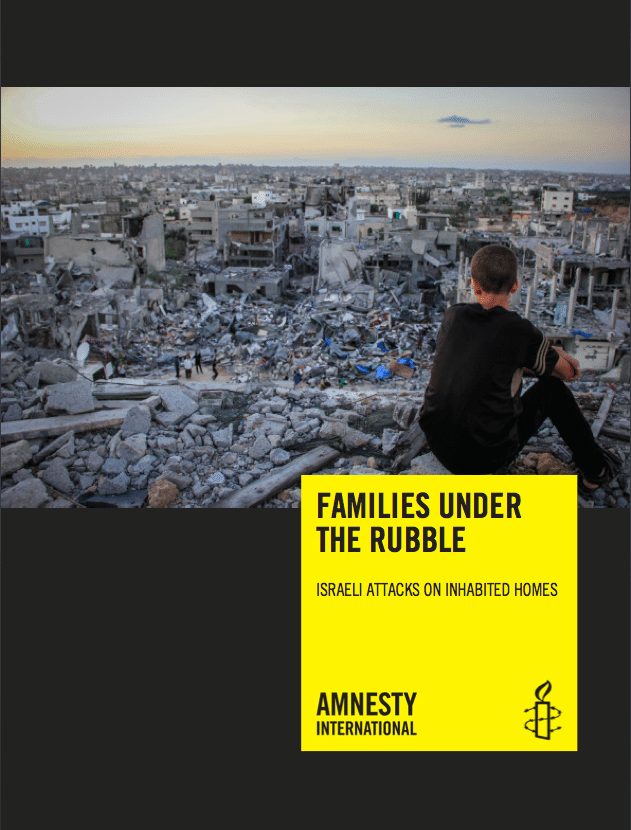Israeli air strikes during Israel’s recent military operation in the Gaza Strip, Operation Protective Edge, targeted inhabited multi-story family homes. Whole families, including many women and children, were killed or injured by these targeted strikes and, in addition, there was extensive destruction of civilian property.
These attacks were carried out in the context of a 50-day conflict, from July 8 until August 26, in which the scale of destruction, damage, death and injury to Palestinian civilians, homes and infrastructure was appalling. According to figures released by the United Nations, some 1,523 civilians, including 519 children, are among more than 2,192 Palestinians who died during the operation. By the time of the ceasefire on August 26 there were approximately 110,000 internally displaced persons living in emergency shelter and with host families. The U.N. estimated that about 18,000 housing units were destroyed or rendered uninhabitable, leaving approximately 108,000 people homeless. A further 37,650 housing units were damaged.
At the same time, Hamas and other Palestinian armed groups fired thousands of indiscriminate rockets and mortar rounds into civilian areas of Israel, killing six civilians, including one child. Dozens of other Israelis, including at least six children, were directly injured by rockets or shrapnel. A total of 66 soldiers were killed in the fighting.
Amnesty International has documented and is continuing to document serious violations of international humanitarian law, including unlawful killings and injuries to civilians and destruction of civilian property, both by Israel and by Hamas and Palestinian armed groups.
In this report Amnesty International examines targeted Israeli attacks carried out on inhabited civilian homes in the light of Israel’s obligations under international humanitarian law, specifically the rules on the conduct of hostilities. It does so by focusing on eight cases, in which targeted Israeli attacks resulted in the deaths of at least 111 people, of whom at least 104 were civilians, including entire families, and destroyed civilian homes. The cases were chosen for a variety of reasons, including the availability of witnesses, the clarity of the evidence and the number of civilians killed. They include two cases in which there were particularly high civilian casualties (at least 33 civilians killed in the bombing of the al-Dali building and 25 in the destruction of the Abu Jame’ family home). In all the cases documented in this report, there was a failure to take necessary precautions to avoid excessive harm to civilians and civilian property, as required by international humanitarian law. In all cases, no prior warning was given to the civilian residents to allow them to escape.
In four of the cases (the attacks on the Abu Jame’ family home, the al-Dali building, the al-Bakri family home and the Abu Dahrouj family home), in which a total of at least 66 civilians were killed, Amnesty International has been able to identify a named individual who was an apparent member of an armed group. However, even if a fighter or a military objective was indeed present (or thought to have been present), the loss of civilian lives, injury to civilians and damage to civilian objects appear disproportionate, that is, out of proportion to the likely military advantage of carrying out the attack, or otherwise indiscriminate. However, due to lack of information from the Israeli authorities, Amnesty International cannot be certain in any of these attacks what was being targeted. In cases where there is no military objective, an attack could violate the international humanitarian law prohibition of direct attacks on civilian objects and on civilians. Attacks directed at civilian objects or at civilians, or disproportionate and indiscriminate attacks that kill or injure civilians are war crimes. The fact that, in these eight cases which caused the deaths of at least 104 civilians, Israel has made no statement about who or what was being targeted, or even acknowledged that it carried out these particular attacks and the loss of civilian lives that they caused, is deeply worrying.
These attacks fit into a broader pattern. In addition to the cases detailed in this report, Amnesty International has documented more than 12 other targeted attacks that caused the deaths of civilians, including children, and destroyed all or part of inhabited home. Most appear to have been aerial attacks conducted by manned aircraft. Looking more widely at Israeli attacks of different kinds, including attacks during heavy fighting in areas such as al-Shuja’iyeh and Khuza’a, the Israeli human rights organization B’Tselem listed 72 homes destroyed in the Gaza Strip in whole or in part with families inside them up until 11 August 2014. This destruction killed 547 people, of whom 125 were women under the age of 60, 250 were minors, and 29 were people over the age of 60.
In all the cases described in this report and other similar ones during the conflict, the onus is on Israel to provide information concerning the attacks and their intended targets. Israel must also explain what precautions were taken to spare civilians in attacks that targeted military objectives but resulted in civilian deaths and injuries and destruction of civilian homes. The cases documented in this report, as well as other credible allegations of serious violations of international humanitarian law, must be promptly, independently and impartially investigated, in accordance with international law and standards and, wherever there is sufficient admissible evidence, alleged perpetrators, be they military or civilian officials, must be brought to justice in proceedings that fully respect international fair trial standards. Civilian victims and their families should receive full reparation. In addition, it is important that, following investigations, the Israeli military should learn the lessons of this and previous conflicts and change its military doctrine and tactics for fighting in densely populated areas such as Gaza so as to ensure strict compliance with international humanitarian law, in particular the principles of distinction, proportionality and precaution.

